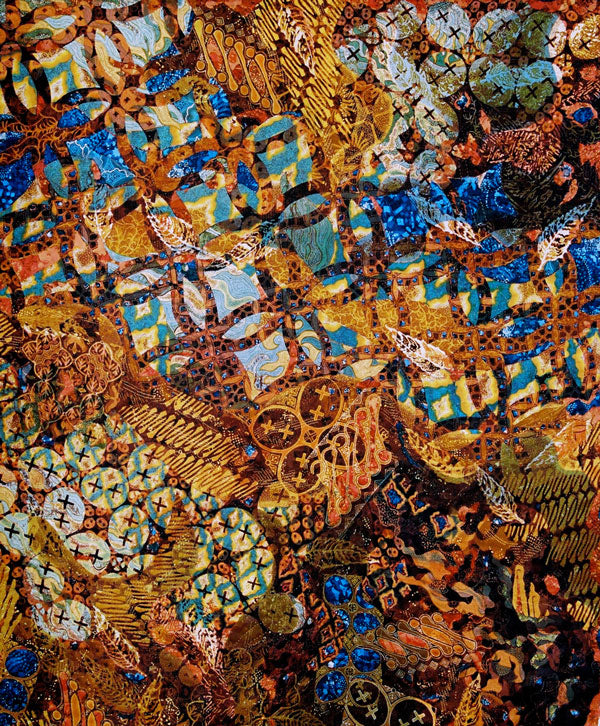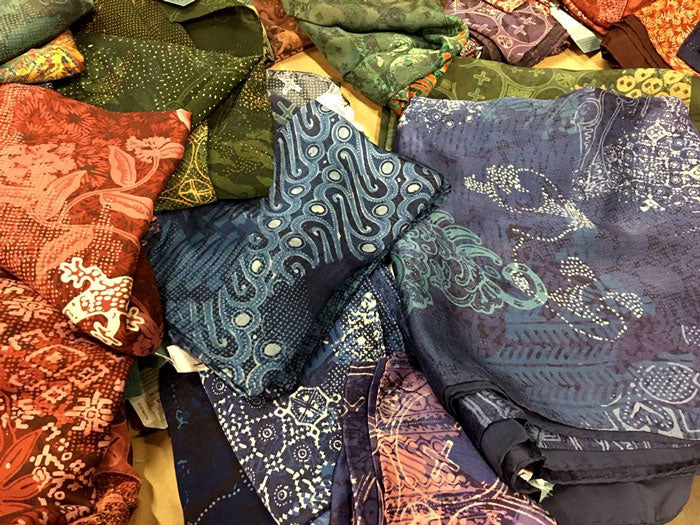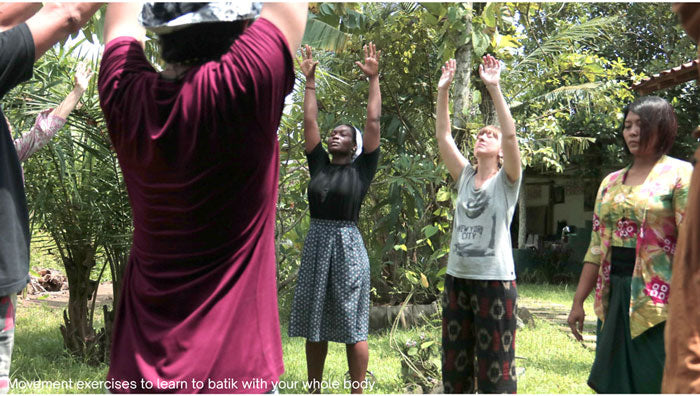2-Day Batik Experience at Artistic Artifacts
Wax / Threads / Roots — A Batik Experience at Artistic Artifacts
Hosted by Babaran Segaragunung Culture House
Saturday, July 26/Sunday, July 27, 2025
10:30 am–4:30 pm, ½ hour lunch break (both days)
Location: Warehouse area of Artistic Artifacts
REGISTER NOW »

The foundation of this workshop is a creative process rooted in ancestral knowledge — what Agus Ismoyo describes as “growth in rootedness.” Drawing from the Javanese concept Ngèlmu Iku Kelakonè Kanthi Laku (knowledge is realized through lived practice), this curriculum invites participants to engage with creativity not just as a skill, but as a way of being.
While batik serves as the central medium, the philosophies and methods taught in this program transcend disciplines, having been shared over the years with painters, writers, designers, dancers, and more. The approach stems from decades of intercultural collaboration with traditional communities in Indonesia, Australia, North America, West Africa, and beyond—revealing shared creative values that go beyond form or medium.
What Will Be Covered in This Two-Day Workshop?
This U.S. workshop is a condensed version of the longer residency programs typically held at Babaran Segaragunung Culture House. It has been adapted to allow for participation over two days:
Day One: Introduction to Batik and its Techniques

- A brief background on batik in the context of Indonesian culture
- Basic introduction to symbolic batik motifs and their meanings
- Embodied Creativity and Inner Sensitivity Introduction to tools and materials (tjanting, stamp, wax, dyes)
- Introductory batik techniques
- Indigo dyeing, exploration of natural dyes, and pattern making
Day Two: Intangible Knowledge and Creative Process—New Techniques
- Basic introduction to symbolic batik motifs and their meanings
- Demo tjap batik
- Introductory batik techniques
- Creating a personal symbol
- Wax removal
Whether you are new to batik or a seasoned artist in another medium, this workshop offers a rare opportunity to experience the richness of culturally rooted creative knowledge through a process that is both structured and deeply personal.
Why This Matters Now
In a world increasingly shaped by speed, surface, and separation, the depth and slowness of traditional creative processes offers a powerful counterpoint. They remind us that creativity is not just a skill — it is a relationship: with ourselves, with others, with nature, and with something larger than all of us.
Today, many heritage arts risk being reduced to commodities, stripped from the cultural ecosystems that once gave them meaning. At the same time, artists and creators everywhere are seeking something more grounded — something that speaks not only to aesthetics, but to intention, connection, and renewal.
This workshop offers a space to pause and return to that deeper current. Through batik and its philosophies, participants are invited to experience a creative process rooted in respect, ritual, and the interconnectedness of all life. These teachings are not exclusive to Indonesian culture—they resonate across borders and disciplines, as Ismoyo and Nia have found in their collaborations with Indigenous artists in Australia, First Nation artists in North America, and traditional makers in Mali and Nigeria.

In learning to work slowly and attentively with wax, cloth, movement, and story, we reconnect with something essential: the idea that creativity is not just about producing — it is about listening, remembering, and belonging. Now, more than ever, we need practices that don’t just make art—but make meaning.
What to Bring
All materials will be provided! Please wear clothing that can get stained and bring a lap cloth to catch drips and a notebook or journal for reflections if desired. Please bring a drawing book and pencils (3B) in case you want to start to draw or prepare your personal symbol design.

Workshop Facilitators
Nia Fliam — Nia Fliam has been engaged with batik since her time at Pratt Institute in New York, where she earned her fine arts degree. What began as a one-year study grant to Indonesia in 1983 became a lifelong commitment to batik as both an artistic and cultural path. In Yogyakarta, she met her partner Agus Ismoyo, and together they founded their studio, Brahma Tirta Sari, in 1985. The studio was built on the principle of collaboration—an ethos they continue to embody in their creation of contemporary fine art batik. Nia studied with Ismoyo’s father, Romo Djayakusuma, a respected teacher of Javanese philosophy, who introduced her to Tribawana, the concept of the Three Worlds—a cosmology that underpins their approach to creativity. This universal creative process, along with the technique of batik, forms the foundation of what will be shared in the workshop.
Desmond Anabrang Fliam-Ismoyo — Desmond grew up immersed in the world of batik, first making his own piece at the age of three. Raised within the philosophy and artistic language of Brahma Tirta Sari and Babaran Segaragunung, he has continued to explore the role of cultural heritage in contemporary life. His academic work has focused on Indonesian cultural policy, particularly the erosion of local wisdom in the arts. In this workshop, he contributes his lived experience of growing up within the lineage of this practice, as well as his own insights into the evolving role of batik and intangible heritage today.
Note on Participation — Agus Ismoyo, co-founder of Brahma Tirta Sari and Babaran Segaragunung Culture House, will accompany the U.S. workshop tour in a supportive and noninstructional role. While he will not be participating as a workshop facilitator, his presence offers participants the opportunity to connect with the broader context and history behind the work of Brahma Tirta Sari.
- Agus Ismoyo and Nia Fliam (Brahma Tirta Sari) Resume: https://bit.ly/Isnia
- Resume Babaran Segaragunung Culture House Profile https://bit.ly/CultureHouseProfile
- Read more about Babaran Segaragunung: http://www.babaransegaragunung.org/

